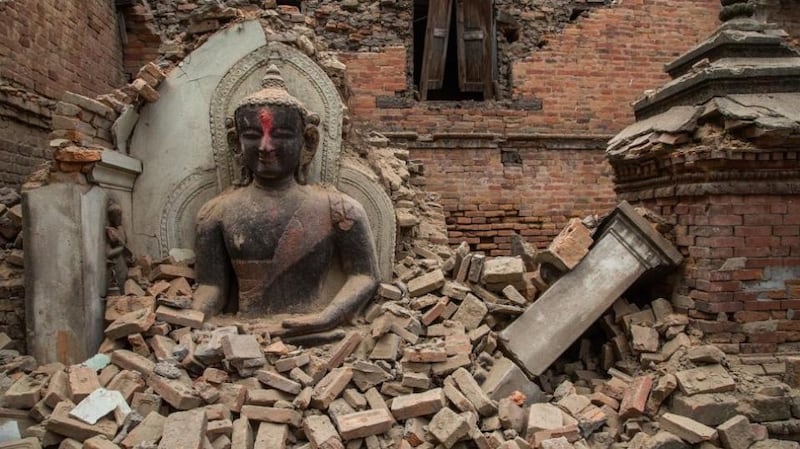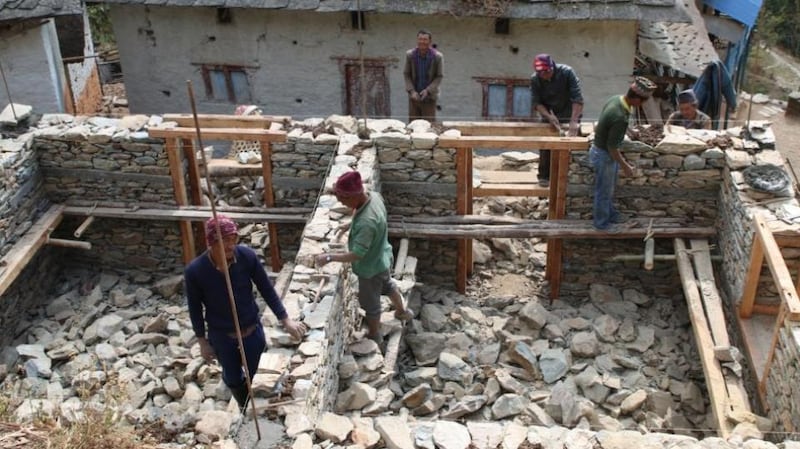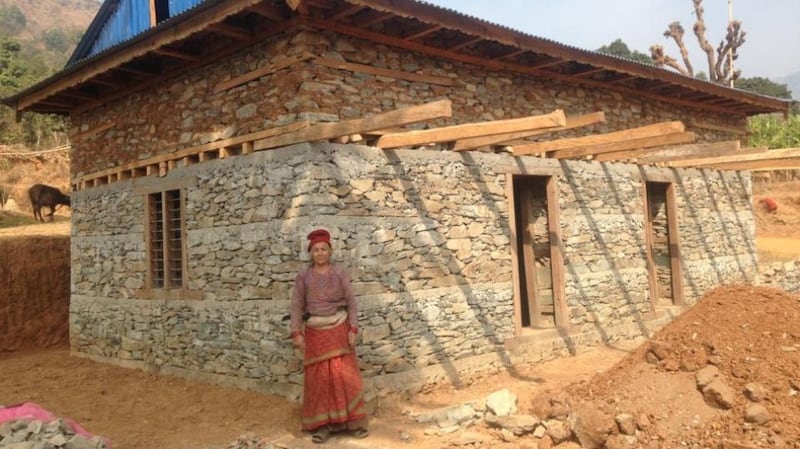Minutes before noon on April 25th, 2015, Siobhán Kennedy and her partner were about to enjoy a cup of tea and some cake, when their fifth-floor apartment in Kathmandu began to shake violently.
“We realised we were too high up to run out, and the stairs isn’t a good place to be, so we stayed under the door frame at the balcony,” says the Galway native.
As everything swayed, she thought the end had come for her. The shaking continued for about 60 seconds “but it felt like 60 hours. It was awful.”
The 7.8-magnitude earthquake devastated Nepal, a landlocked Himalayan country. Almost 9,000 people were killed and 3.5 million left homeless in a country that already ranked as one of the poorest in Asia. Around 800,000 buildings were destroyed or damaged, including many of Nepal's venerated Buddhist and Hindu temples that today still lie in ruins.

Hundreds of aftershocks struck in the days and weeks that followed, including a 7.3-magnitude quake on May 12th, leaving an entire nation battered and exhausted.
The aftermath has seen Irish engineers such as Kennedy and members of Engineers Without Borders Ireland (EWBI), an NGO and charity, work in some of the most remote and challenging terrain on Earth. Kennedy, who in November was awarded Engineers Ireland's International Engineer of the Year accolade, previously worked on post-disaster relief following the earthquake in Haiti in 2010, and by 2013 moved to Nepal with her partner. Back then, she worked for the rural access programme, where she initiated and ran a programme that saw Nepali engineering graduates accumulate experience by working with mentors.

Landslides
But in a few moments that terrible spring day in 2015 their lives changed forever. The earthquake destroyed or damaged more buildings than the far deadlier quakes that shattered Haiti in 2010 and Kashmir in 2005. More than 10,000 landslides demolished roads and villages, while an avalanche at Everest base camp, 150km east of Kathmandu, killed 21 sherpas and climbers.
Such was the force of the earthquake – it packed seismic energy equivalent to 504 Hiroshima atomic bombs – that it moved Mount Everest three centimetres to the southwest. The days after the quake saw public squares turned into temporary shelters for millions of people too afraid to sleep indoors.
Kennedy was hired as the recovery officer at Nepal’s Housing Recovery and Reconstruction Platform (HRRP). Her work sees her documenting the ongoing reconstruction effort which she shares with stakeholders such as donors and government officials. HRRP’s teams spend up to a week at a time working in earthquake-affected districts and are a vital link between communities and the state.

Government-issued grants are handed out to help homeowners build new homes in three stages: 50,000 rupees (about €370) at the application stage, 150,000 rupees when a house foundation is finished and passes inspection by engineers, and 100,000 rupees upon completion of the roof. An advantage of building a house to code, other than its durability, experts say, is that families could use it as collateral.
Last year, the authorities introduced deadlines to encourage qualified homeowners to avail of the payments.
Not surprisingly for a catastrophe of this scale, the recovery hasn’t been without problems. The government-issued grants cover only 30-50 per cent of the cost of rebuilding a dwelling house, meaning families must take out loans that many say are impossible to repay.
“The deadlines are an issue, they push people in the wrong direction a bit,” says Kennedy. “There are a lot of people building what are called ‘earthquake houses’ – a one-storey, one-room house they build just to get the grant. They may be still living in the damaged house, if it’s still standing. It’s not what is going to be their home.”
The government-issued deadlines are regularly extended to allow more applications get in. While people in major urban areas may be aware the deadlines are flexible, many in remote districts, where details are slow to get through, may not.
False rumours abound, says Kennedy, that those who don’t apply in time would be placed on a so-called blacklist that could also threaten their access to social security benefits.
“You’ll hear people say it’s not enough to build a house – it was never intended to be enough to build a house. The government set an amount that would significantly contribute to and incentivise people to build new homes. It’s a credit to the government that the grants are getting so much funding out to earthquake-affected households and that needs to be acknowledged,” says Kennedy.

Very few completion certificates are being issued by the authorities, however, because homeowners are modifying their houses – adding, for example, another storey. “I’m not certain homeowners won’t ever get the remainder of the grant, but for the engineers it becomes very complicated.”
Bribes
Last year the Guardian reported that international aid agencies complained they were being forced to pay bribes and fees to state bureaucrats to get approval for their projects. "Some of the barriers we found included an initial ban on international NGOs participating in reconstruction projects," says EWBI director Declan Alcock. "And in June 2015, the ministry of finance demanded that international NGOs pay a 43 per cent tax on corrugated iron sheeting for shelters, arguing that the emergency was over."
Alcock, originally from Baltinglass, Co Wicklow, lived in Nepal for six months prior to the 2015 earthquake and says that for these and other reasons EWBI focused its initial efforts on aid distribution.
“Some of these projects included financial assistance to Tibetan refugees in the Pokhara area. In many ways they were some of the most vulnerable as they are not recognised as citizens by the Nepal government,” he says.
At the same time, the earthquake has fuelled much innovation and resilience. Hundreds of young Nepalis who might otherwise have ended up as poorly-paid migrant workers in the Gulf have instead been trained as engineers to oversee rebuilding work in the worst-affected rural areas.
“It was a major achievement and commitment for the government to hire and deploy close to 3,000 engineers to support the reconstruction,” says Kennedy. It also means they play a key role in rebuilding their country as well as providing technical capacity to local authorities in the future.
Since 2013, EWBI has been running a design initiative called “Where there is no engineer”, focusing on development solutions, and which is part of the curriculum at engineering courses in DIT and Trinity College. The initiative’s open-source projects have helped communities in Nepal set up and distribute social enterprises, including biochar kilns that burn organic waste material, turning it into biochar that’s then used to improve soil quality.
In May last year, the EWBI team responsible for the biochar kiln project carried out workshops in Bittizor and other villages situated about 100km east of Kathmandu. “Considering almost 70 per cent of people in Nepal are subsistence farmers with small plots of land, a 40 per cent increase in [crop] yield can have a significant benefit,” says Alcock.
Other experts have pointed out that though governments and international agencies surge to help in the immediate aftermath of a major disaster such as the earthquake in Nepal, assistance is just as important in the years that follow.
Limited impact
Maggie Stephenson from Kilkenny, a post-earthquake reconstruction specialist and senior adviser to Nepal’s national reconstruction authority, says the international community can best help countries afflicted by natural disasters by acknowledging that short-term and front-loaded assistance in the first year has limited impact.
“Nepal is going to take at least a decade to recover, anywhere in the world would take that long to recover from such a major crisis, and it requires different kinds of help at different times to do so,” she says. “There were and are lots of supporters involved in Nepal, but it’s not only a question of assisting the most vulnerable directly. It’s about being strategic to support local systems and effect large-scale impacts for recovery.”
In Kathmandu and the valley surrounding it, life today goes on. Its durbar squares – Unesco world heritage sites – are thronged with people socialising and marking festivals. For Kennedy, who cycles through Kathmandu’s chaotic streets to and from her office every day, the working environment is tough and patriarchal, though she points out that’s not unique to Nepal.
“I find the caste system difficult; the longer I’m here the more I realise it influences every interaction,” she says. Other difficulties include the changing of government officials she works with, though with a more stable government now in place she expects that to become less of an issue.
Reflecting on the weeks following the earthquake, Kennedy says she stayed in Nepal and worked for more than two months before taking a break. “It was a planned holiday, it was much needed at that point,” she says. “But then, how lucky are we that we got to go on holidays?”










